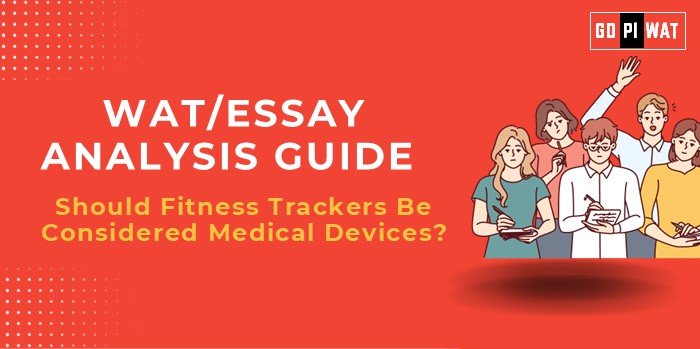📋 Written Ability Test (WAT) Analysis Guide: Should Fitness Trackers Be Considered Medical Devices?
🌐 Understanding the Topic’s Importance
Fitness trackers bridge lifestyle and healthcare, raising critical questions about their role in preventive care, innovation, and regulation.
📝 Effective Planning and Writing
- ⏱️ Time Allocation:
- Reading & Planning: 5 minutes
- Writing: 20 minutes
- Review: 5 minutes
- 📚 Preparation Tips:
- Gather facts on wearable device market trends and regulations.
- Identify examples, e.g., Apple Watch, and explore global regulatory frameworks.
💡 Introduction Techniques
- ⚖️ Contrast: “While fitness trackers empower millions to lead healthier lives, their accuracy and regulatory oversight remain contentious, begging the question of whether they should be medical devices.”
- ✅ Solution-Based: “By adopting a tiered regulatory system, we can balance innovation in fitness trackers with public health needs.”
📖 Structuring the Essay Body
1. Achievements:
- 📈 Include stats like growing market share and life-saving health features.
- 📡 Use examples of successful integration in telemedicine.
2. Challenges with Comparative Analysis:
- ⚠️ Discuss regulatory and data privacy hurdles.
- 🌏 Compare approaches, e.g., USA’s FDA vs. EU’s MDR frameworks.
3. Future Outlook:
- 🤖 Highlight innovations like AI-enhanced wearables.
- 📜 Suggest regulatory models fostering both safety and innovation.
✍️ Concluding Effectively
- ⚖️ Balanced: “Fitness trackers occupy a transformative yet ambiguous role in healthcare. Striking a balance between innovation and regulation will unlock their true potential.”
- 🌍 Global Perspective: “Drawing lessons from the USA and EU, a nuanced regulatory framework can ensure fitness trackers serve public health without stifling innovation.”
🔍 Analyzing Successes and Shortcomings
Key Achievements:
- 📊 Democratized access to health data.
- 🌟 Spurred innovation in preventive healthcare.
Ongoing Challenges:
- ⚠️ Inconsistencies in accuracy and regulation.
- 🔐 Privacy risks with personal health data.
🎯 Recommendations for Sustainable Progress
- 📑 Implement a hybrid classification for devices based on functionality.
- 📢 Mandate transparency on device limitations.
- 🤝 Foster collaboration between tech companies and health authorities.
✍️ Sample Short Essays
1. Balanced Perspective (100 Words):
Fitness trackers have blurred the line between consumer tech and medical devices, offering health insights to millions. However, inaccuracies and inconsistent regulations raise concerns about their reliability. A hybrid classification system would ensure advanced models meet medical standards without stifling innovation in basic trackers.
2. Solution-Oriented (100 Words):
Regulating fitness trackers as medical devices can enhance their reliability while protecting consumers. By implementing a tiered regulatory framework, governments can safeguard public health while supporting innovation, ensuring wearable tech’s evolution benefits everyone.
3. Global Comparison (100 Words):
Unlike the USA’s selective FDA approvals, the EU’s MDR imposes broader regulations, exemplifying stricter oversight of wearables. Adopting global best practices, fitness trackers can balance accuracy, accessibility, and innovation to redefine healthcare.


